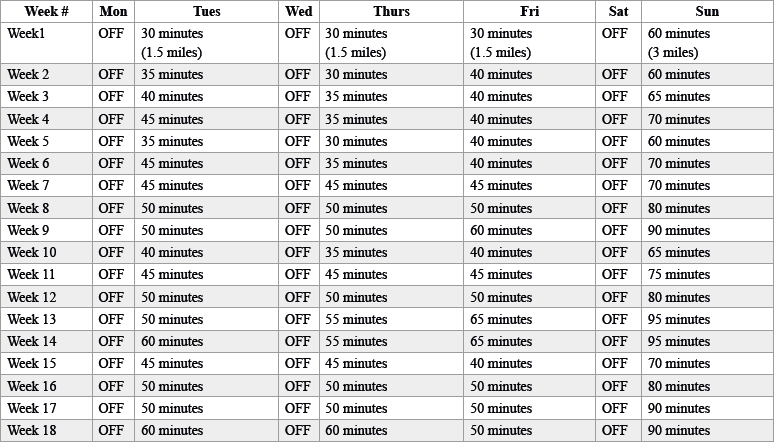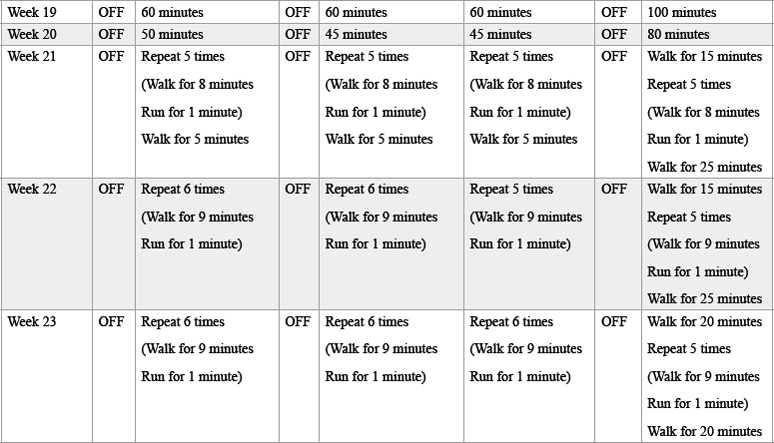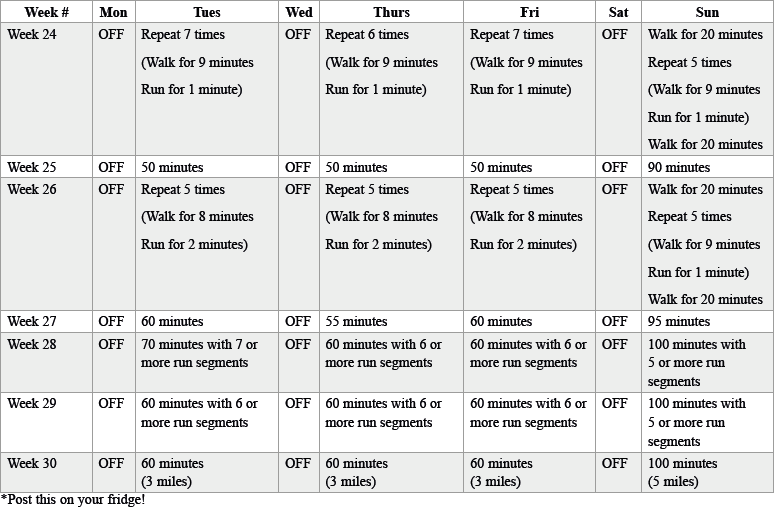

In our view, using Rx Run-Walk is just like taking medicine. Let us explain briefly why we feel confident prescribing Rx Run-Walk for you. First, Rx Run-Walk is ideally suited to achieving activity levels recommended by the United States Physical Activity Guidelines Advisory Committee (150 minutes [2.5 hours] of moderate intensity physical activity every week). Rx Run-Walk is based on guidelines and evidence, just like medicine. Next, there is a specific amount of run-walk you need to take during the week to improve many health conditions. We think of this amount of run-walk as a dose, just like there are doses for medications. Finally, if you don’t take your Rx Run-Walk, it doesn’t work—just like if you miss your medication, it can’t help. You have to follow the instructions carefully to get the effect you want.
Running and walking consistently is enough to attain better biomarkers (health numbers) and feel better. When used consistently over 12 weeks, the gentle exercise of Rx Run-Walk changes the brain on a neurochemical basis resulting in better energy, a happier outlook, and positivity. That’s why we believe the vast majority of women can improve their health using Rx Run-Walk and also why we want you to start an Rx Run-Walk training program whether or not you decide to change other parts of your life. However, you should know that when combined with adequate sleep (Rx Sleep) and healthy eating (Rx Eat), weight loss often results from Rx Run-Walk. Weight loss provides additional health and wellness. Rx Run-Walk is one kind of endurance exercise that protects against loss of muscle which means you lose weight in fat rather than muscle.
Everyone needs a pedometer and should record their total number of steps every day during the 30-week program. Regardless of which prescription program you are following, aim to get at least 5,000 to 6,000 steps per day every day. More is better!
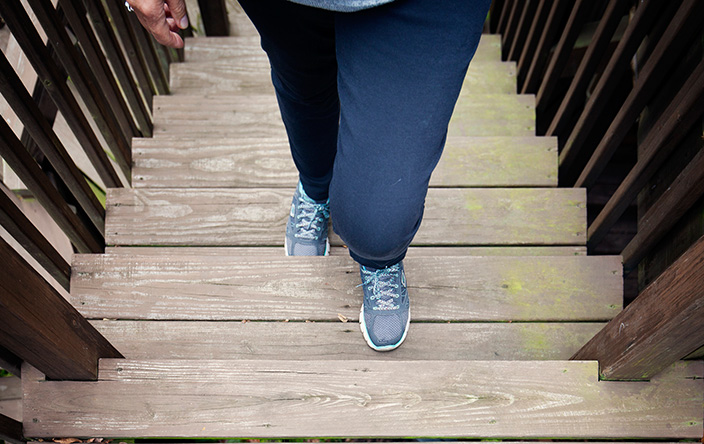
Because we start at different points, we need to find what fits your baseline health now so you can start a training program that fits with where you are. Over the next 30 weeks, the right training program will help you gradually reach the full dose of Rx Run-Walk. So let’s find which of the three Rx Run-Walk programs is best for you—Rx Get Started, Rx Keep Going, or Rx Burn Fat. Answer a couple screening questions, then use the chart below to see which chapters are most relevant to your health needs.
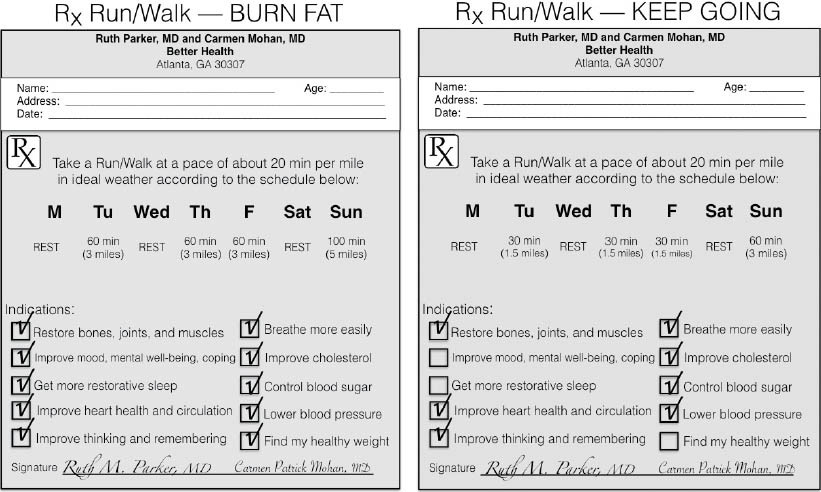
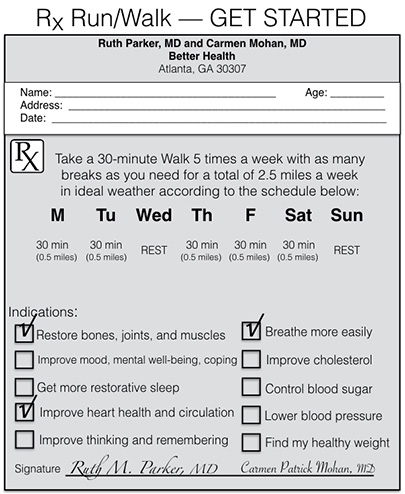
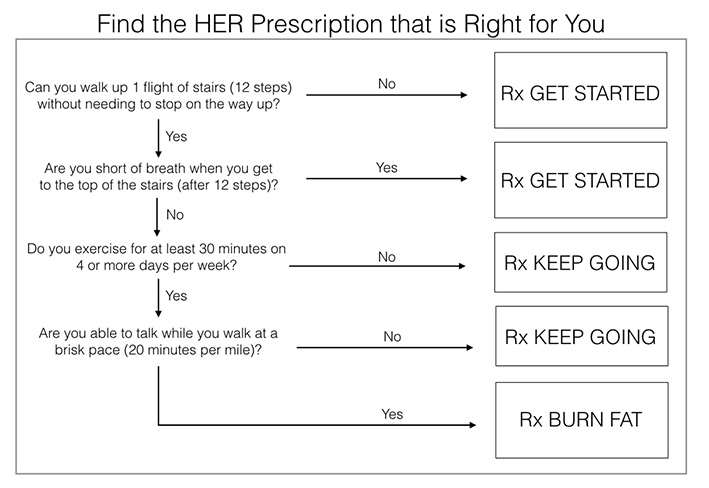
The prescriptions reflect the level of Rx Run-Walk you will be able to master by the end of the matching Rx Run-Walk training program. Each course feeds into the next course. For example, if you were routed into Keep Going it means you are likely ready to begin Week 1 of the Keep Going training program. After 30 weeks of consistently using the Keep Going training program, you will reach the full dose of Rx Run-Walk needed to create fundamental health.
One word of caution. We haven’t met any woman who doesn’t want to burn fat. The trouble is that burning fat through Rx Run-Walk requires a certain level of fitness and time. If you try to ignore where you really are, and start in a program that isn’t right for you, you’ll end up injured. Don’t do this. Instead, realize that you’ll be able to do the Burn Fat program in time. After about 12 to 16 weeks of taking Rx Run-Walk at full dose, you should consider coming back to the Find Your Prescription Tool. It’s likely you’ll be ready to begin the next training program, Burn Fat.
This program assumes you partner with your doctor as you do the program.
1.Talk to your doctor.
2.Show your doctor the training schedule.
3.Ask your doctor if any modifications are recommended.
4.Be sure you understand and know how to follow instructions for all of your medications.
5.Do NOT begin this program if you require supplemental oxygen from a home oxygen tank OR you have been hospitalized in the last month.

By the end of this 30-week Rx Run-Walk: Get Started training program, you will have laid the foundation for improving mobility and increasing your body’s ability to metabolize energy.
The first four weeks of the Get Started training program are a quick start to cultivating an exercise habit. Beneath the number of the week, you will see the total walking time allotted for the week. The program begins with week 1 in which you will walk for 40 minutes total. The program ends with week 30 in which you will walk for 150 minutes total, thereby reaching the full dose of prescribed exercise.
Remaining injury-free is the single most important predictor of improvement in walking endurance. To succeed in this program, you must embrace the following principle: the body builds itself after a challenge while it is at rest. This means you should take breaks as many times as you need and for as long as you need to catch your breath. We can’t emphasize this principle enough. If you take a break BEFORE you feel fatigued, you will not only help to build your ability to walk for a longer time, but you will also prevent injury.
In this program, every minute you spend walking counts toward your daily time. If you park your car at the grocery store and walk inside, that minute counts toward your daily goal. By the end of your walks, you should feel like you could go for at least 2 more minutes if needed. You should NOT feel completely exhausted. Maintain a pace that is right for you so that you are feeling good at the end of each day. Remember: NO huffing and puffing.
You may notice that every fifth week is a lower duration week. This is intentional. These weeks will help your body build muscle and strengthen tendons—two of the most injury-prone parts of the body. For this reason, we call lower duration weeks recovery weeks. Weeks 5, 10, 15, 20, and 25 are recovery weeks. During recovery weeks, focus on obtaining the recommended 7 or more hours of sleep nightly, maintaining good nutrition, taking good care of any weak links, and treating any aches appropriately.
The last four weeks are maintenance weeks. They are there so you can prove to yourself that maintaining your prescribed run-walk schedule is not only well within your grasp, but you’ve been able to handle it well for almost a month!
You have a great deal of control over the part of life that revolves around exercise if you choose to take charge. The way you schedule your walks, your rewards, and your challenges will significantly influence your motivation. You can also control how good you feel during each walk and how quickly you recover.
Motivation Tips
 Find a place in your schedule when you are very likely to have time to walk. For most people this means getting up 40 minutes earlier. Don’t skimp on sleep! Instead, go to bed 40 minutes earlier. Even better, go to sleep an hour earlier. Your body needs the restorative sleep anyway.
Find a place in your schedule when you are very likely to have time to walk. For most people this means getting up 40 minutes earlier. Don’t skimp on sleep! Instead, go to bed 40 minutes earlier. Even better, go to sleep an hour earlier. Your body needs the restorative sleep anyway.
 Get your spouse, significant other, friends, co-workers, etc., to be your support team. Promise that if you get through the next three weeks having done the run-walks, you will have a party for them, or a picnic, or whatever! Pick supportive people who will email you, and will be supportive during and after the training, and during the celebration.
Get your spouse, significant other, friends, co-workers, etc., to be your support team. Promise that if you get through the next three weeks having done the run-walks, you will have a party for them, or a picnic, or whatever! Pick supportive people who will email you, and will be supportive during and after the training, and during the celebration.
 Have a friend or three who you can call in case you have a low motivation day. Just the voice on the phone can usually get you out the door. Of course, it is always best to have a positive and enthusiastic person in this role.
Have a friend or three who you can call in case you have a low motivation day. Just the voice on the phone can usually get you out the door. Of course, it is always best to have a positive and enthusiastic person in this role.
 It is best to also have a backup time to walk. The usual backup times are at noon or after work.
It is best to also have a backup time to walk. The usual backup times are at noon or after work.
 Break your walk into several segments if necessary.
Break your walk into several segments if necessary.
There is no need to ever experience pain in a walking program. But this puts on you, the new walker, the responsibility of a slow enough pace and frequent enough rests. You can have fun when you walk—every single time—if you don’t spend all of the resources early. That said, we do make recommendations for duration of the walking segments you attempt. The recommended duration of walking before taking a break gradually increases every five weeks. If you are finding you consistently need a break before the recommended walk segment is up, your body probably needs more time to adapt to your new exercise program. Count back four weeks in the training schedule, and try those weeks again. You may need to do this a number of times, or once early on as you get started and again mid-schedule like in weeks 18 or 24.
Plan scheduled breaks but remember you can always take another break if you need it. Scheduled breaks should be 1 to 3 minutes each (longer if needed). Some days, you’ll need more rest, some days you’ll need less. This is part of learning your body and its needs. During the break, you can walk at a much slower pace—essentially just shuffling your feet low to the ground—sit down, or just stand still long enough to feel recovered. Raise your arms over your head. Prepare your mind by saying this mantra aloud or silently to yourself, “Lead with your heart. Smile on your face. Wind at your back.” Focus on your breathing. Build energy for the next walk segment.

The most important week is your first week, and it only takes 30 seconds to get started!
The truth is any amount of activity is better than sitting around. Standing up is better for you than sitting. Walking is better than standing. Even if you walk for just 30 seconds before sitting back down, it’s better for your health than doing nothing at all.
It’s time to learn by doing. Here is a first-time-out instruction list that will ease you into walking—a shakedown cruise for your body.
To get the mind ready for exercise, many walkers have a cup of coffee, tea, or diet drink about an hour before they walk. If your blood sugar level is low due to any reason (especially in the afternoon), eat about half of an energy bar or drink 100-200 calories of a sports drink—especially one that has about 20% protein—about 25-30 minutes before the start of the run. If you have problems with caffeine, don’t use it.
1.Put on a pair of comfortable walking shoes.
2.Put on light comfortable clothes. Note: Clothes don’t have to be designed for exercise—just comfortable.
3.Set a timer for 30 seconds. The timer can be your watch, phone, or an egg timer, or you can just count 30 steps.
4.Walk for 30 seconds at a slow enough pace to keep your breathing easy. You should be able to talk as you walk.
5.Take a break. Stand still and rest. Sit down if you need to. Take as long as you need to catch your breath, cool down, and feel comfortable again.
6.Alternate 30 seconds of walking at a comfortable pace with the breaks you need.
7.Do this for a total of 8 minutes walking—no more.
8.Use a gentle stride, which is relaxed and not long.
For example, you might start with a 30-second walk and need 2 minutes of rest followed by a walk of 30 seconds, then another minute of rest. Next, walk 30 seconds followed by 2 minutes of rest, walk 30 seconds then another minute of rest. The total time spent walking would be 2 minutes. Those 2 minutes would count toward your goal of 8 minutes of walking. You might then decide to take an extended break and come back during your lunch hour for a workout with a different pattern—walk 30 seconds, rest 30 seconds, walk 30 seconds, rest 30 seconds—alternating in this fashion for a total of 12 repeats which would give you another 6 minutes of walking time. That’s it—you’ve reached your goal of 8 minutes total walking time for the day.
Again, only you can decide how much rest you need to keep your breathing even and easy. Maybe you need only 10 to 15 seconds of rest, maybe you need several minutes to catch your breath. You will make considerable gains by sticking to your walking time goals no matter how long your break times are.
Repeat the same routine as the first time but reduce the total walk time to 6 minutes.
Rest completely. Let your body recover.
You’re back to the routine again. Repeat the alternating 30 second walk-break cycle you did on your first walk for a total time of 8 minutes spent walking.
You’re in the groove now—just 6 minutes total to do today, 30 seconds at a time.
This is the challenge day. You’re going to walk for 12 minutes total. Do this in any fashion you can, with walks no more than 30 seconds at a time. For example, if you feel too fatigued after 6 minutes of walk-rest, go ahead and take a long break—even if it means several hours go by before you try again. It’s the cumulative (total) time spent walking that matters. Just make sure you get to the total time of 12 minutes.
After you have finished your first week, congratulate yourself with a special walking outfit, meal, or trip to a great walking area or park. Remember that rewards can be very powerful.
Congratulations! You’re on your way to becoming a regular walker!
If there is any time in your life when you adjust your schedule so that you can exercise, this is it!
If you can maintain the next three weeks of walking (only 15 days of walking), you have about an 80% chance of continuing walking for 6 months. And if you make it to the six-month club, you will tend to continue as a life-long walker.
Here are some tips for your 21-day mission:
•Schedule your run-walk days at least two weeks in advance.
•Commit to the prescribed schedule of Tuesdays, Thursdays, Fridays, and Sundays. Get out there on the designated days. If you wait until the spirit moves you to walk, you will probably have many empty spaces in your training journal.
•Pick a time when the temperature is okay for you and a time period you usually have open. Lock it in!
•Plan. You must also be in charge of the little things that keep the schedule filled, such as spending a few minutes each week to plan your weekly walks and to reward yourself afterward.
•Journal! The commitment to yourself to simply get out there four times a week will be reinforced significantly by writing it down.
•Stick to it! Regularity is important for the body and the mind. When you have three exercise-free days between walks, you start to lose some of your walking conditioning and adaptations.
Mission: You are continuing to increase distance. On Saturday, pick a scenic place for your workout. Each day, repeat the 30-second walk and 1- to 3-minute rest cycle to reach the total walking time goal listed below:
Monday: 8 minutes
Tuesday: 6 minutes
Thursday: 8 minutes
Friday: 6 minutes
Saturday: 16 minutes
Mission: You’re really making progress now! On Saturday, ask some friends to go with you for the walk and have a picnic afterward. You’ve made it 3 weeks! Keep going, you have an easy week coming. Each day, repeat the 30-second walk and 1- to 3-minute rest cycle to reach the total walking time goal listed below:
Monday: 10 minutes
Tuesday: 6 minutes
Thursday: 8 minutes
Friday: 8 minutes
Saturday: 18 minutes
Mission: It’s time for your 3-week party. Pick the day and the place, and celebrate the fact you’re able to walk 20 minutes! Each day, repeat the 30-second walk and 1- to 3-minute rest cycle to reach the total walking time goal listed below:
Monday: 10 minutes
Tuesday: 6 minutes
Thursday: 8 minutes
Friday: 6 minutes
Saturday: 20 minutes
Mission: Time for your first recovery week. Rest a bit. You’ve earned it! Plus, your body needs it to prepare for the next part of your journey.
Monday: 8 minutes
Tuesday: 6 minutes
Thursday: 8 minutes
Friday: 6 minutes
Saturday: 12 minutes
It’s time to increase the duration of the walk segments and gradually remove the breaks. Starting with week 6, the recommended duration of the walk segment increases every 5 weeks. However, you should determine the amount of walking-resting each day that allows you to feel good with no aches and pains. Shoot for goals that are within your reach but also challenging. Remember, no huffing and puffing! Add more walking and less resting but keep the huffing under control.
If you have not yet been able to walk for 30 seconds continuously, don’t worry. This means your body needs more time to adjust. To reduce the chance of injury, start the training program again beginning with week 1. You should also talk with your doctor about this training program, show your doctor your journal pages, and ask for further recommendations to keep you on the Rx Run-Walk path.
Congratulations on completing your Rx Run-Walk: Get Started training program! You are walking enough to
 restore bones, joints, and muscles;
restore bones, joints, and muscles;
 breathe more easily; and
breathe more easily; and
 improve heart health and circulation.
improve heart health and circulation.
You can continue to enhance these health benefits by consistently following your walking prescription for 12 weeks.
After 12 weeks of following the Rx Run-Walk: Get Started training program, it’s time to make plans to continue. The Keep Going training program starts to increase the distance you cover by gradually removing the breaks you’re allowed to take. We invite you to consider starting the Keep Going training program when you feel good for at least 12 weeks (i.e., one season) of taking the prescribed Get Started walks at full dose (week 30). When you’re thinking about moving on to the training program for the Keep Going course, take a moment to revisit chapter 3 to see if the Keep Going course is right for you.
Fill this out and post it on the fridge!
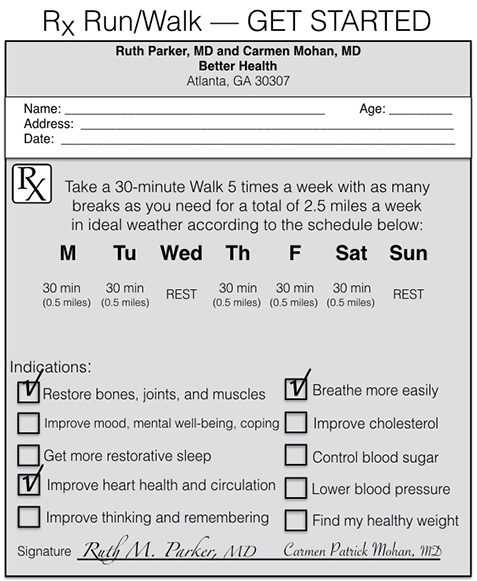
Download the following sheet for convenient use.
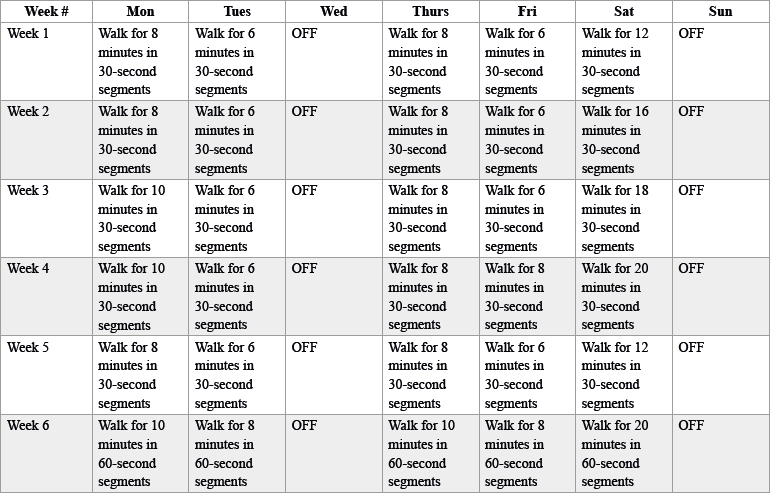
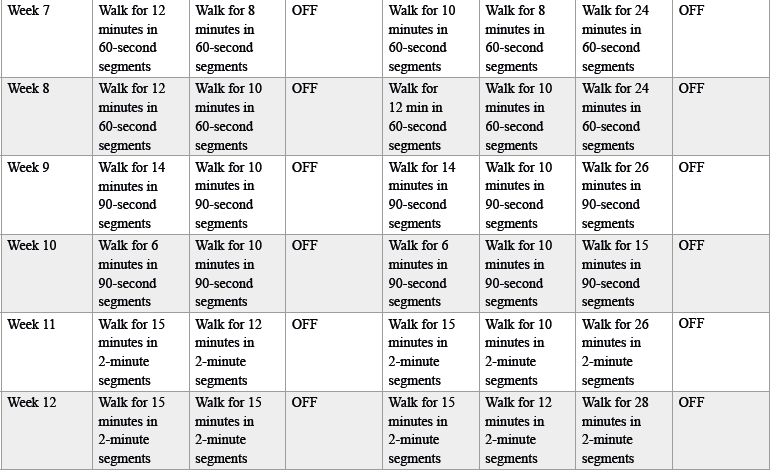
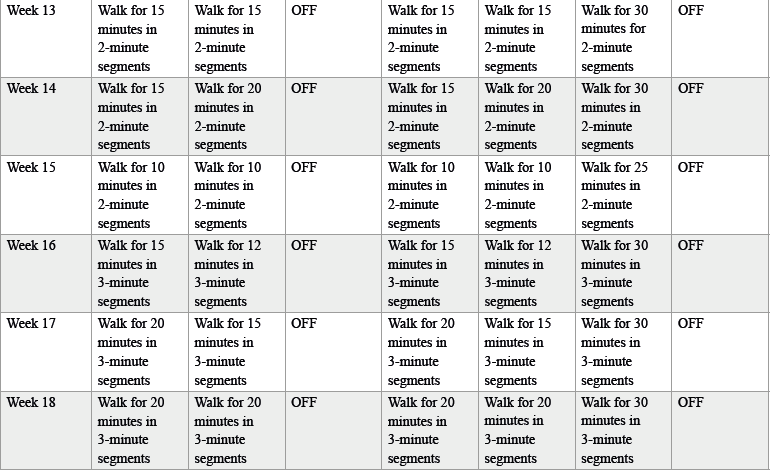
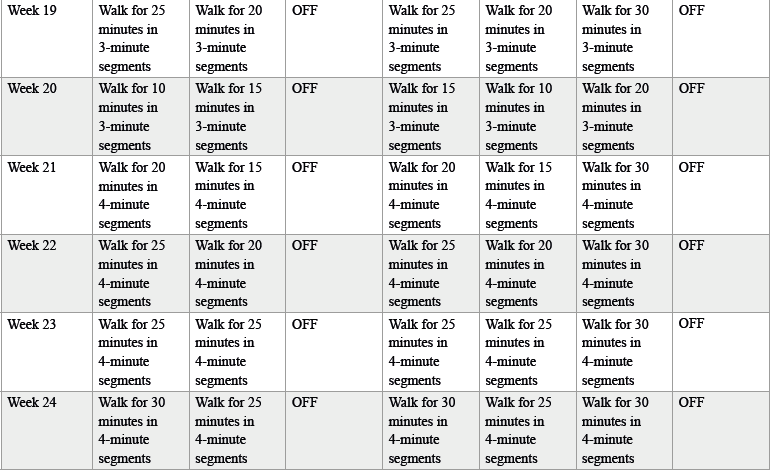
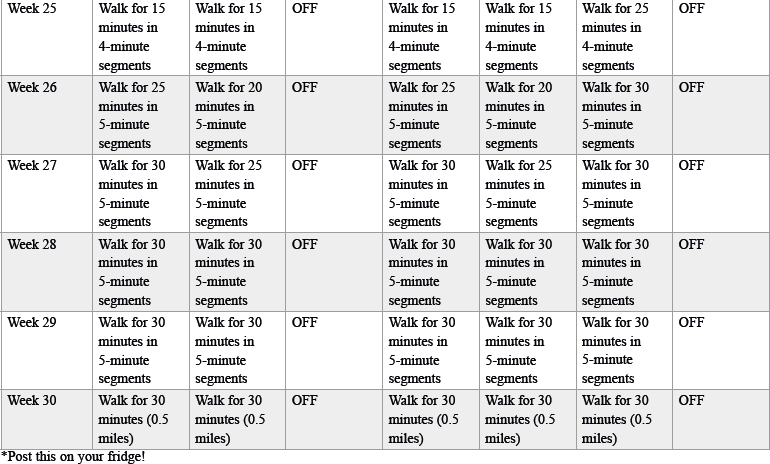
Before you embark on this training program, you should be able to walk at a conversational pace for at least 5 minutes without needing a break.
1.Look at week 1. If the long walk for Sunday on week 1 exceeds your current ability, we recommend you begin with the training program for the Get Started course.
2.Show your doctor the training schedule.
3.Ask your doctor if any modifications would be recommended.
4.Be sure you understand and know how to follow instructions for all of your medications.
By the end of this 30-week Rx Run-Walk: Keep Going training program, you will be able to run-walk at the level required to maintain the fundamentals of health.
The first eight weeks of Rx Run-Walk: Keep Going build the foundation for walking endurance. While we recommend specific durations for both the walking segments and the break segments, you should take breaks before you feel fatigued to help increase your ability to walk longer distances. The program begins with week 1 in which you will walk for 40 minutes total. The program ends with week 30 in which you will walk for 150 minutes total thereby reaching the full dose of prescribed exercise. By the end of your walks, you should feel like you would be able to walk for at least 5 to 10 more minutes if needed. That is, you should NOT feel completely exhausted. Maintain a pace that is right for you so that you are feeling good at the end of each workout.
Remaining injury-free is the single most important predictor of improvement in walking endurance. To succeed in this program, you must embrace the following principle: the body builds itself after a challenge while it is at rest.
We can’t emphasize breaks enough. If you take a break BEFORE you feel fatigued, you will not only cultivate your ability to walk for a longer time, but you will also prevent injury. There is no need to ever experience pain in a walking program. But this puts on you, the new walker, the responsibility of a slow enough pace and frequent enough rests. You can have fun when you walk—every single time—if you don’t spend all of your resources early.on as you get started and again mid-schedule like in weeks 18 or 24.
That said, we do make recommendations for the number of breaks you take to stop and rest or even sit down if you need to. The recommended duration of walking before taking a break gradually increases every five weeks. If you are finding you consistently need more breaks than the training schedule recommends, your body probably needs more time to adapt to your new exercise program. Count back four weeks in the training schedule, and try those weeks again. You may need to do this a number of times, or once early on as you get started and again mid-schedule like in weeks 18 or 24.
During this program, you are asked to run on some of the Sunday walks. By run, we mean pick up your pace from a comfortable walk at conversational pace to a brisk walk where you can still talk albeit in short sentences. Remember: NO huffing and puffing. You can also consider a jog (or shuffle) for the recommended run segments.
Note: The shuffle is a motion between running and walking. From a walk, you would shorten your stride, keep your feet low to the ground and pick up the cadence. The ankle should do most of the work so that the muscles don’t have to do much work.
During weeks 25 through 29, you’ll notice the increased time and frequency of the run segments. These weeks will help you increase your speed and gradually build up to the recommended 20-minute mile pace.
You will notice this plan will gradually increase week to week and then suddenly go down on the total run-walk time. This is intentional. These lower duration weeks will help your body build muscle and strengthen tendons. For this reason, we call them recovery weeks. Weeks 7, 11, 16, 22, and 26 are recovery weeks. During these weeks, focus on obtaining the recommended 7 or more hours of sleep nightly, maintaining good nutrition, taking good care of any weak links, and treating any aches appropriately.
The last four weeks are maintenance weeks. They are there so you can prove to yourself that maintaining your prescribed run-walk schedule is not only well within your grasp, but you’ve been able to handle it well for over a month!
Motivation Tips
 Find a place in your schedule when you are very likely to have time to walk. For most people this means getting up 40 minutes earlier. Don’t skimp on sleep! Instead, go to bed 40 minutes earlier. Even better, go to sleep an hour earlier. Your body needs the restorative sleep anyway.
Find a place in your schedule when you are very likely to have time to walk. For most people this means getting up 40 minutes earlier. Don’t skimp on sleep! Instead, go to bed 40 minutes earlier. Even better, go to sleep an hour earlier. Your body needs the restorative sleep anyway.
 Get your spouse, significant other, friends, co-workers, etc., to be your support team. Promise that if you get through the next 3 weeks having done the run-walks, you will have a party for them, or a picnic, or whatever! Pick supportive people who will email you, and will be supportive during and after the training, and during the celebration.
Get your spouse, significant other, friends, co-workers, etc., to be your support team. Promise that if you get through the next 3 weeks having done the run-walks, you will have a party for them, or a picnic, or whatever! Pick supportive people who will email you, and will be supportive during and after the training, and during the celebration.
 Have a friend or three who you can call in case you have a low motivation day. Just the voice on the phone can usually get you out the door. Of course, it is always best to have a positive and enthusiastic person in this role.
Have a friend or three who you can call in case you have a low motivation day. Just the voice on the phone can usually get you out the door. Of course, it is always best to have a positive and enthusiastic person in this role.
 It is best to also have a backup time to walk. The usual backup times are at noon or after work.
It is best to also have a backup time to walk. The usual backup times are at noon or after work.
 Break your walk into several segments if necessary.
Break your walk into several segments if necessary.
Tips on Form as You Run-Walk
When you walk, one foot is on the ground at any time. Running in any form means that there will be a second or less when both feet are off the ground. This requires a bit more effort. Most beginners can insert a few short jogs of 5-10 seconds, after a few weeks of walking. But if you aren’t comfortable doing this, just alternate between a gentle walk and a brisk walk.
Note on stride length: Whether walking or jogging, don’t use a long stride. Keep the feet low to the ground, touch lightly and keep the stride fairly short (see the folowing photos). This allows the ankle to do a lot of the work, reducing stress on the muscles, joints, and feet.
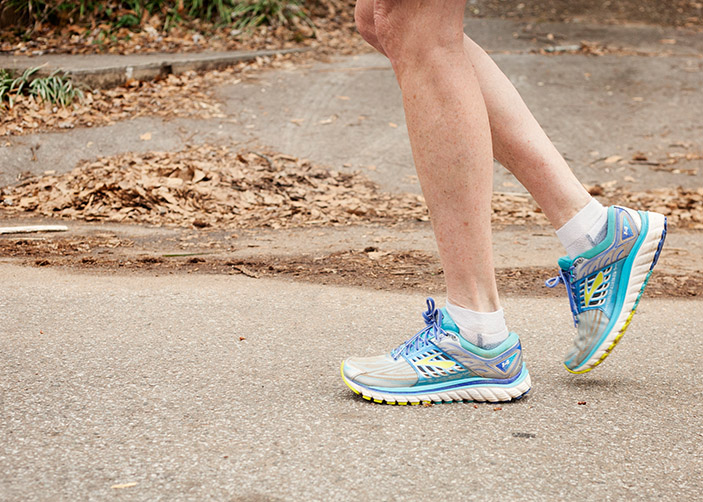

The training program recommends scheduled breaks, but remember that you can always take another break if you need it. Scheduled breaks should be 1 to 3 minutes each (longer if needed). Some days, you’ll need more rest, some days you’ll need less. This is part of learning your body and its needs. During the break, you can walk at a much slower pace—essentially just shuffling your feet low to the ground. You can also sit down, or stand still long enough to feel recovered. Raise your arms over your head. Prepare your mind by saying this mantra aloud or silently to yourself, “Lead with your heart. Smile on your face. Wind at your back.” Focus on your breathing. Build energy for the next walk segment.
The most important week is your first week, and it only takes 12 minutes to get started!
It’s time to learn by doing. Here is a first run-walk instruction list that will ease you into the program—a shakedown cruise for your body.
To get the mind ready for exercise, many walkers have a cup of coffee, tea, or diet drink about an hour before they walk. If your blood sugar level is low due to any reason (especially in the afternoon), eat about half of an energy bar or drink 100-200 calories of a sports drink—especially one that has about 20% protein—about 25-30 minutes before the start of the run. If you have problems with caffeine, don’t use it.
Prepare your mind for your new schedule. Make a list of reasons you want to become a regular walker. Think of some of your challenges and make a plan for how to manage them so you achieve the daily goals. This will be useful in maintaining your motivation in the coming days.
1.Put on a pair of comfortable walking shoes.
2.Put on light comfortable clothes. Note: Clothes don’t have to be designed for exercise—just comfortable.
3.Set a timer for 5 minutes. The timer can be on your watch or phone.
4.Walk for 5 minutes at a slow enough pace to keep your breathing easy. You should be able to talk as you walk.
5.Take a break. Stand still and rest. Sit down if you need to. The recommended break duration is 2 minutes, but take as long as you need to catch your breath, cool down, and feel comfortable again.
6.Do it again. Walk for 5 minutes at your own pace.
7.You’re done! You’ve walked for 10 minutes total.
Rest completely. Let your body recover.
Repeat the same routine as the first time but reduce the total walk time to 5 minutes.
You’re back to the routine again. Repeat the alternating 5-minute walk and 2-minute break cycle you did on your first walk for a total time of 10 minutes spent walking.
Another day off for complete rest.
You’re in the groove now! Walk for 5 minutes, take a break for 2 minutes (longer if needed), and repeat the walk-break cycle 3 times for a total of 15 minutes spent walking.
After you have finished your first week, congratulate yourself with a special walking outfit, meal, or trip to a great walking area or park. Remember that rewards can be very powerful.
Congratulations! You’re on your way to becoming a regular walker!
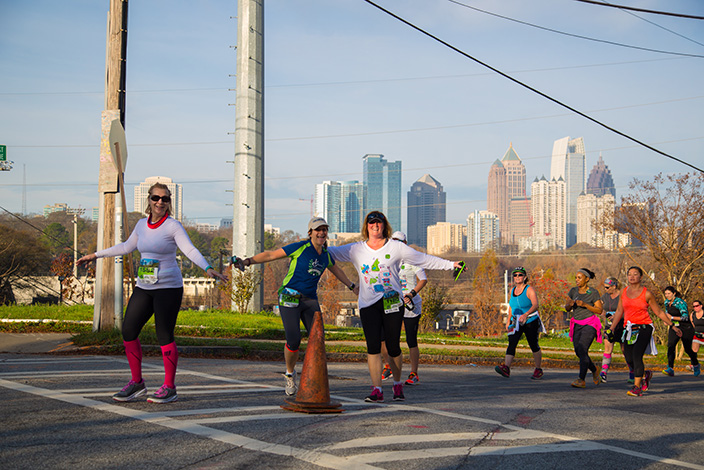
If there is any time in your life when you adjust your schedule so that you can exercise, this is it!
If you can maintain the next three weeks of walking (only 12 days of walking), you have about an 80% chance of continuing walking for 6 months. And if you make it to the six-month club, you will tend to continue as a life-long walker.
Here are some tips for your 21-day mission:
•Schedule your run-walk days at least two weeks in advance.
•Commit to the prescribed schedule of Tuesdays, Thursdays, Fridays, and Sundays. Get out there on the designated days. If you wait until the spirit moves you to walk, you will probably have many empty spaces in your training journal.
•Pick a time when the temperature is okay for you and a time period you usually have open. Lock it in!
•Plan. You must also be in charge of the little things that keep the schedule filled, such as spending a few minutes each week to plan your weekly walks and to reward yourself afterward.
•Journal! The commitment to yourself to simply get out there four times a week will be reinforced significantly by writing it down.
•Stick to it! Regularity is important for the body and the mind. When you have three exercise-free days between walks, you start to lose some of your walking conditioning and adaptations.
Mission: You are continuing to increase distance. On Sunday, pick a scenic place for your workout. Each day, alternate the 5-minute walk with a break of 2 minutes to reach the total walking time goal listed below:
Tuesday: 10 minutes
Thursday: 5 minutes
Friday: 10 minutes
Sunday: 20 minutes
Mission: You’re really making progress now! On Sunday, ask some friends to go with you for the walk and have a picnic afterward. You’ve made it 3 weeks. Keep going! On the weekdays, alternate the recommended walk segment with a break of 2 minutes to reach the total walking time goal listed here:
Tuesday: 15 minutes
Thursday: 5 minutes
Friday: 10 minutes
Sunday: 10 minutes (Note: Breaks are removed and runs are introduced on this workout. You are up to the challenge!)
Mission: It’s time for your 3-week party. Pick the day and the place, and celebrate the fact that you’re able to walk 25 minutes! On the weekdays, alternate the recommended walk segment with a break of 2 minutes to reach the total walking time goal listed below:
Tuesday: 15 minutes
Thursday: 10 minutes
Friday: 10 minutes
Sunday: 25 minutes (Note: This is the challenge day which improves your endurance. Take as many breaks as you need for as long as you need to reach the total walking time.)
Mission: Time for your first recovery week. Rest a bit. You’ve earned it.
Tuesday: 5 minutes
Thursday: 10 minutes
Friday: 15 minutes
Sunday: Alternate walking 3 minutes with a run of 30 seconds for a total time of 10 minutes and 30 seconds
NOTE: The gentlest running form is a shuffle. Keep your feet low to the ground with a light touch and a short stride. This will give you a slight increase in exertion without overwhelming the feet, legs, and joints.
It’s time to increase the duration of the walk segments and gradually remove the breaks. Starting with week 6, the recommended duration of the walk segment increases every 2 weeks. However, you should determine the amount of walking and resting each day that allows you to feel good with no aches and pains. Shoot for goals that are within your reach but also challenging. Remember, no huffing and puffing! Add more walking and less resting but keep the huffing under control.
Note: There is no goal in this program to keep increasing the running every workout. While the short run segments improve mental activity and fitness, if you are challenged by a given amount of running, take a 5-minute walk and start over with shorter run segments.
If you have not yet been able to walk continuously for 10 minutes, don’t worry. This means your body needs more time to adjust. To reduce the chance of injury, start the training program again beginning with week 1. You should also talk with your doctor about this training program, show your doctor your journal pages, and ask for further recommendations to keep you on the Rx Run-Walk path.
Download the following sheet for convenient use.
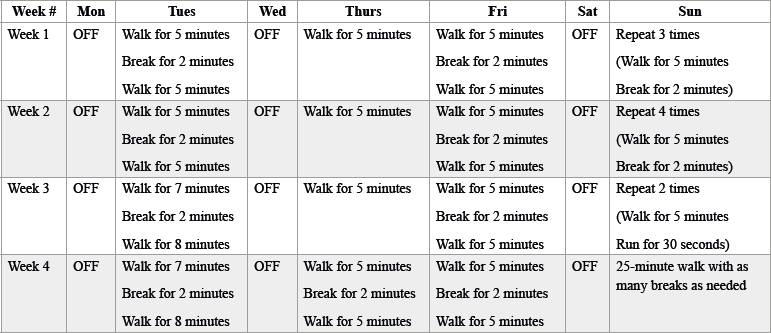
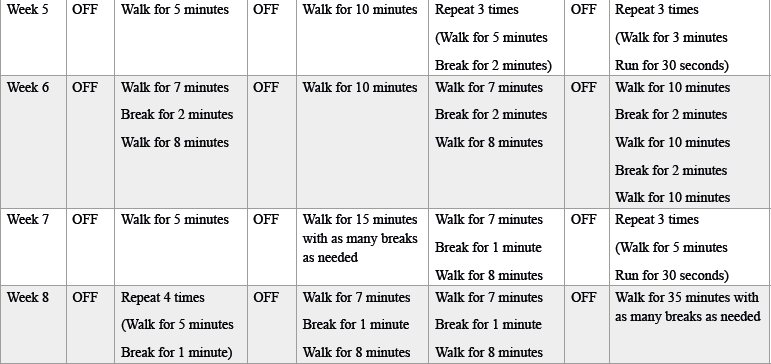
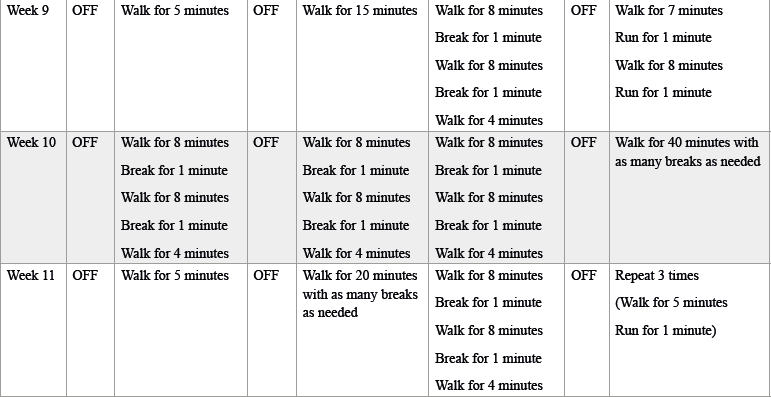
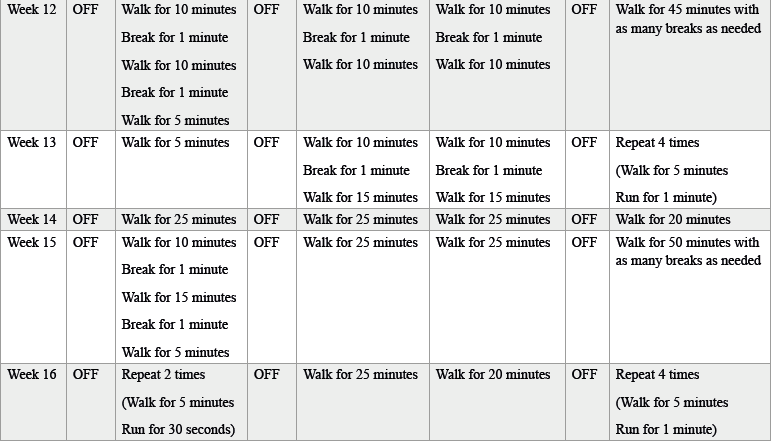
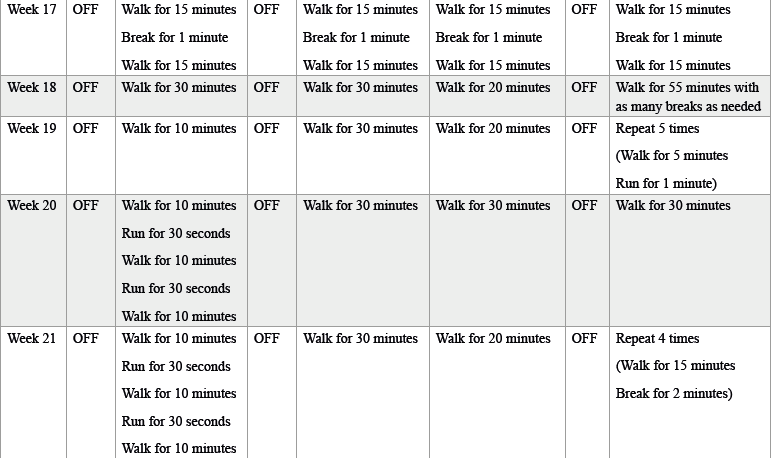
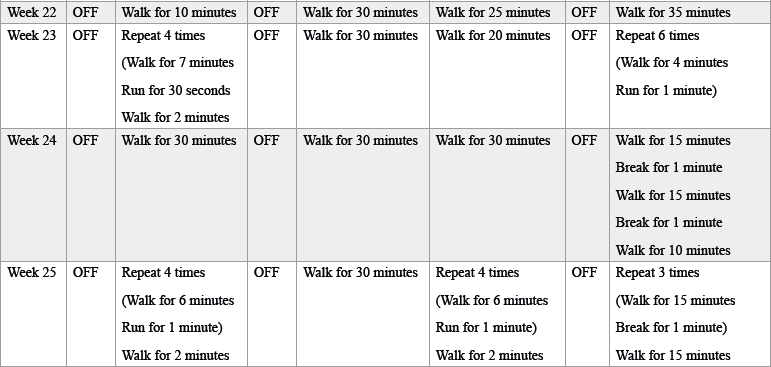
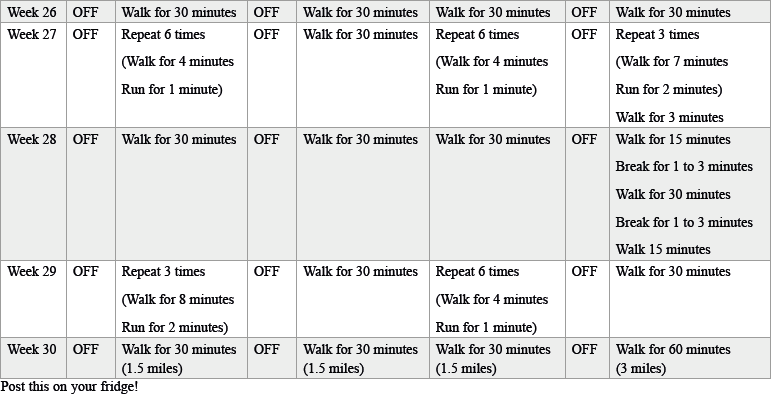
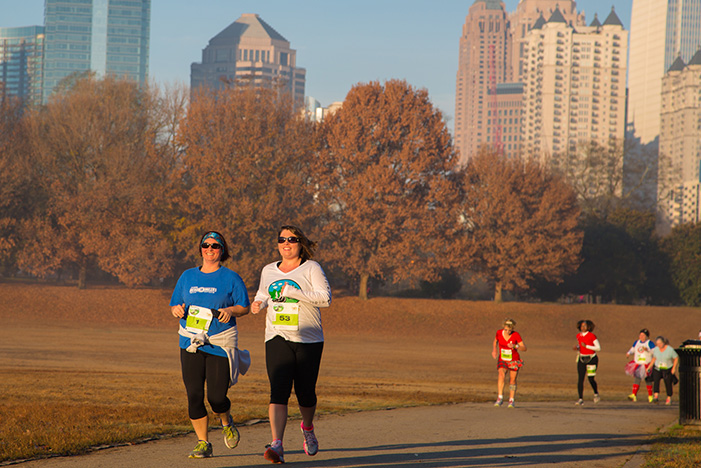
Congratulations on completing your Keep Going training program! You are walking enough to
 restore bones, joints, and muscles;
restore bones, joints, and muscles;
 improve heart health and circulation;
improve heart health and circulation;
 improve thinking and remembering;
improve thinking and remembering;
 breathe more easily;
breathe more easily;
 improve cholesterol;
improve cholesterol;
 control blood sugar; and
control blood sugar; and
 lower blood pressure.
lower blood pressure.
Good news! You can further enhance these health benefits by consistently following your walking prescription.
Fill this out and post it on your fridge!
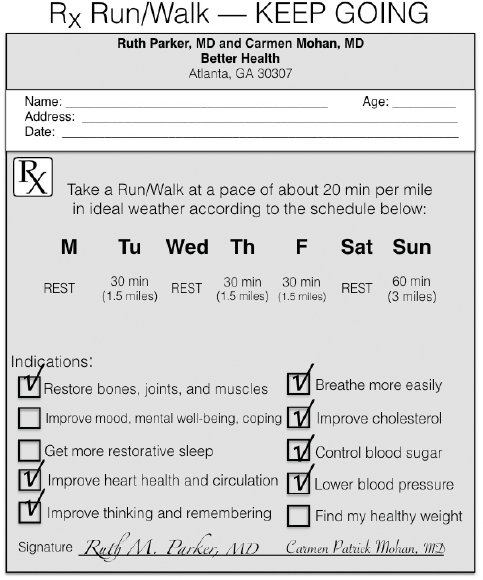
Now it’s time to make plans on how to keep going even further. Continue the week 30 prescription dose for 12 weeks. This will give you the level of fitness required to start the Fat Burning training program. The Fat Burning training program gradually increases the amount of time you are able to run-walk so you perform the level of exercise required to burn off excess fat and begin to develop a leaner physique.
We invite you to consider starting the Fat Burning training program when you feel good for at least 12 weeks (i.e., one season) of taking the run-walks prescribed in week 30 of the Keep Going training program. When you’re thinking about moving on to the Fat Burning training program, take a moment to revisit chapter 3 to see if you meet the other prerequisites.
Get bonus points! Go be a spectator at a 5K or 10K near you. Watch what happens at the finish line. Think “that could be me.” You can find a race online or through Jeff’s website: www.jeffgalloway.com The Barb 5K is a particular favorite of ours.
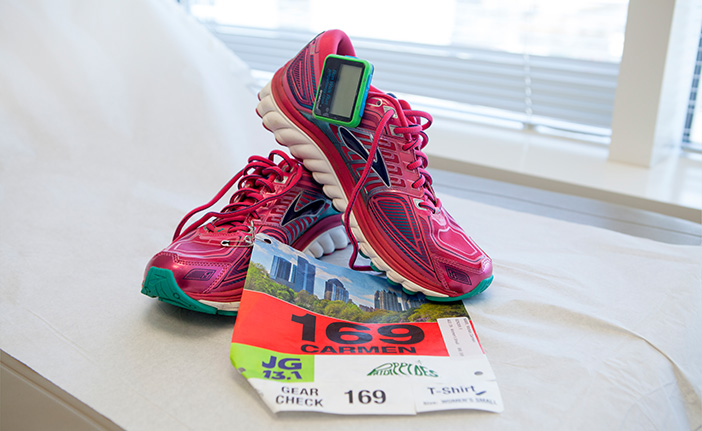
Before you embark on this training program, you should be able to walk at a conversational pace (about 20 minutes per mile) for at least 60 minutes with only a short break if you take one at all.
1.Look at week 1. If the long walk for Sunday on week 1 exceeds your current ability, we recommend you begin with the Keep Going training program.
2.Show your doctor the training schedule.
3.Ask your doctor if any modifications are recommended.
4.Be sure you understand and know how to follow instructions for all of your medications.
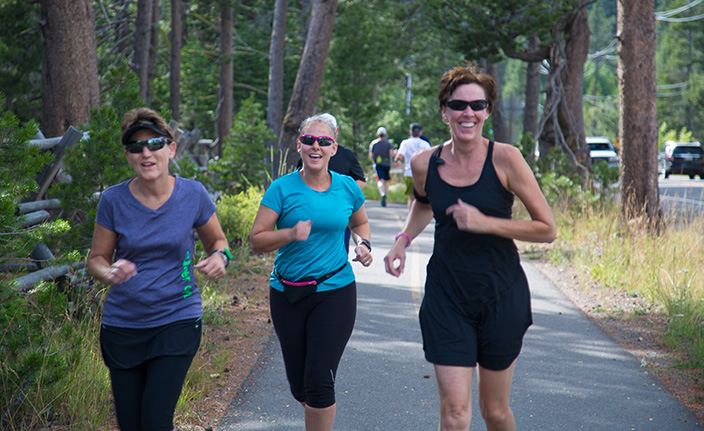
By the end of this 30-week course, you will be able to use run-walk to gain recreational fitness. In addition, you will lose about 0.5 to 1 pound of fat weekly because you are also following the Rx Eat: Burn Fat.
The first eight weeks of the Fat Burning training program expand the foundation for walking endurance from 60 minutes to 90 minutes. This amount of walking is required because fat is metabolized only after the first 30 to 45 minutes of walking. One 90-minute walk will burn anywhere between 300 and 450kcal of fat. To lose one pound, a woman needs to burn about 500kcal per day, or about 3500 kcal weekly.
The program begins with week 1 in which you will walk for 150 minutes total. The program ends with week 30 in which you will run-walk for 280 minutes total, thereby reaching the full dose of prescribed exercise. By the end of your run-walk, you should feel like you would be able to walk for at least 5 to 10 more minutes if needed. That is, you should NOT feel completely exhausted. Maintain a pace that is right for you so that you are feeling good at the end of each workout.
This program gradually builds your walking endurance over 20 weeks before introducing run segments in week 21. By run, we mean pick up your pace from a comfortable walk at conversational pace to a brisk walk where you can still talk albeit in short sentences. Remember: NO huffing and puffing. You can also consider a jog for the recommended run segments or consider the shuffle.
Note: The shuffle is a motion between running and walking. From a walk, you would shorten your stride, keep your feet low to the ground and pick up the cadence. The ankle should do most of the work so that the muscles don’t have to do much work.
By week 28, you should adjust the ratio of walking time versus running time. A certain number of run segments are recommended, but you get to decide how long you want them to be. A total run-walk time is recommended.
Motivation Tips
 Find a place in your schedule when you are very likely to have time to walk. For most people this means getting up 40 minutes earlier. Don’t skimp on sleep! Instead, go to bed 40 minutes earlier. Even better, go to sleep an hour earlier. Your body needs the restorative sleep anyway.
Find a place in your schedule when you are very likely to have time to walk. For most people this means getting up 40 minutes earlier. Don’t skimp on sleep! Instead, go to bed 40 minutes earlier. Even better, go to sleep an hour earlier. Your body needs the restorative sleep anyway.
 Get your spouse, significant other, friends, co-workers, etc., to be your support team. Promise that if you get through the next 3 weeks having done the run-walks, you will have a party for them, or a picnic, or whatever! Pick supportive people who will email you, and who will be supportive during and after the training, and during the celebration.
Get your spouse, significant other, friends, co-workers, etc., to be your support team. Promise that if you get through the next 3 weeks having done the run-walks, you will have a party for them, or a picnic, or whatever! Pick supportive people who will email you, and who will be supportive during and after the training, and during the celebration.
 Have a friend or three who you can call in case you have a low motivation day. Just the voice on the phone can usually get you out the door. Of course, it is always better to have a positive and enthusiastic person in this role.
Have a friend or three who you can call in case you have a low motivation day. Just the voice on the phone can usually get you out the door. Of course, it is always better to have a positive and enthusiastic person in this role.
 It is best to also have a backup time to walk. The usual backup times are at noon or after work.
It is best to also have a backup time to walk. The usual backup times are at noon or after work.
 Break your walk into several segments if necessary.
Break your walk into several segments if necessary.
When you walk, one foot is on the ground at any time. Running in any form means that there will be a second or less when both feet are off the ground. This requires a bit more effort. Most beginners can insert a few short jogs of 5-10 seconds, after a few weeks of walking. But if you aren’t comfortable doing this, just alternate between a gentle walk and a brisk walk.
Note on stride length: Whether walking or jogging, don’t use a long stride. Keep the feet low to the ground, touch lightly and keep the stride fairly short. This allows the ankle to do a lot of the work, reducing stress on the muscles, joints, and feet.
The most important week is your first week, it only takes 30 minutes to get started!
It’s time to learn by doing. Here is a first run-walk instruction list that will ease you into the program—a shakedown cruise for your body.
To get the mind ready for exercise, many walkers have a cup of coffee, tea, or diet drink about an hour before they walk. If your blood sugar level is low due to any reason (especially in the afternoon), eat about half of an energy bar or drink 100-200 calories of a sports drink—especially one that has about 20% protein—about 25-30 minutes before the start of the run. If you have problems with caffeine, don’t use it.
Prepare your mind for your new schedule. Make a list of reasons you want to become a regular run-walker. Think of some of your challenges and make a plan for how to manage them so you achieve the daily goals. This will be useful in maintaining your motivation in the coming days.
1.Put on a pair of comfortable walking shoes.
2.Put on light comfortable clothes. Note: Clothes don’t have to be designed for exercise—just comfortable.
3.Set a timer for 30 minutes. The timer can be on your watch or phone.
4.Walk for 30 minutes at a slow enough pace to keep your breathing easy. You should be able to talk as you walk.
Rest completely. Let your body recover.
Repeat the same routine as the first time.
You’re back to the routine again; walk 30 minutes.
Another day off for complete rest.
You’re in the groove now! Walk for 60 minutes, ideally in a scenic place you enjoy.
After you have finished your first week, congratulate yourself with a special walking outfit, meal, or trip to a great walking area or park. Remember that rewards can be very powerful.
Congratulations! You’re on your way to fat burning!

If there is any time in your life when you adjust your schedule so that you can exercise, this is it!
If you can maintain the next three weeks of walking (only 12 days of walking), you have about an 80% chance of continuing walking for 6 months. And if you make it to the six-month club you will tend to continue as a life-long walker. Here are some tips for your 21-day mission:
•Schedule your run-walk days at least two weeks in advance
•Commit to the prescribed schedule of Tuesdays, Thursdays, Fridays, and Sundays. Get out there on the designated days. If you wait until the spirit moves you to walk, you will probably have many empty spaces in your training journal.
•Pick a time when the temperature is okay for you and a time period you usually have open. Lock it in!
•Plan. You must also be in charge of the little things that keep the schedule filled, such as spending a few minutes a week to plan your weekly walks and to reward yourself afterward.
•Journal! The commitment to yourself to simply get out there four times a week will be reinforced significantly by writing it down.
•Stick to it! Regularity is important for the body and the mind. When you have three exercise-free days between walks, you start to lose some of your walking conditioning and adaptations.
Mission: You are ready to increase distance. On Sunday, pick a scenic place for your workout.
For each day, walk for the total time goal listed below:
Tuesday: 35 minutes
Thursday: 30 minutes
Friday: 40 minutes
Sunday: 60 minutes
Mission: You’re really making progress now! On Sunday, ask some friends to go with you for the walk and have a picnic afterward. You’ve made it 3 weeks. Keep going!
Tuesday: 40 minutes
Thursday: 35 minutes
Friday: 40 minutes
Sunday: 65 minutes
Mission: It’s time for your 3-week party. Pick the day and the place, and celebrate the fact you’re able to walk 70 minutes!
Tuesday: 45 minutes
Thursday: 35 minutes
Friday: 40 minutes
Sunday: 70 minutes (This is the challenge day which improves your endurance. Take as many breaks as you need for as long as you need to reach the total walking time.)
Mission: Time for your first recovery week. Rest a bit. You’ve earned it.
Tuesday: 35 minutes
Thursday: 30 minutes
Friday: 40 minutes
Sunday: 60 minutes
Time to further increase the duration of the walk segments and gradually quicken your pace so you can start to run. You should determine the amount of walking and running each day that allows you to feel good with no aches and pains. Shoot for goals that are within your reach but that are also challenging. Remember, no huffing and puffing! Add slower walking or shuffling when needed to keep the huffing under control.
If you have not yet been able to walk continuously for 70 minutes, don’t worry. This means your body needs more time to adjust. To reduce the chance of injury, start the training program again beginning with week 1. You should also talk with your doctor about this training program, show your doctor your journal pages, and ask for further recommendations to keep you on the walking path.
Congratulations on completing your Burn Fat training program! You are now run-walking enough to
 restore bones, joints, and muscles;
restore bones, joints, and muscles;
 improve mood, mental well-being, and coping;
improve mood, mental well-being, and coping;
 get more restorative sleep;
get more restorative sleep;
 improve heart health and circulation;
improve heart health and circulation;
 improve thinking and remembering;
improve thinking and remembering;
 breathe more easily;
breathe more easily;
 improve cholesterol;
improve cholesterol;
 control blood sugar;
control blood sugar;
 lower blood pressure; and
lower blood pressure; and
 find your healthy weight.
find your healthy weight.
Good news! You can further enhance these health benefits by consistently following your Rx Run-Walk prescription.
Fill this out and post it on your fridge!

Now it’s time to make plans on how to keep going. Decide on your weight loss goal. Continue the week 30 prescription dose for the number of weeks equal to the number of pounds you want to lose. It’s likely you still have miles to go and you’ll want some company. Research shows that women who exercise with a group are more likely to stick with their programs. You are now ready to join a Jeff Galloway training group or related program. Visit www.JeffGalloway.com and click on “Training Programs” for more information.
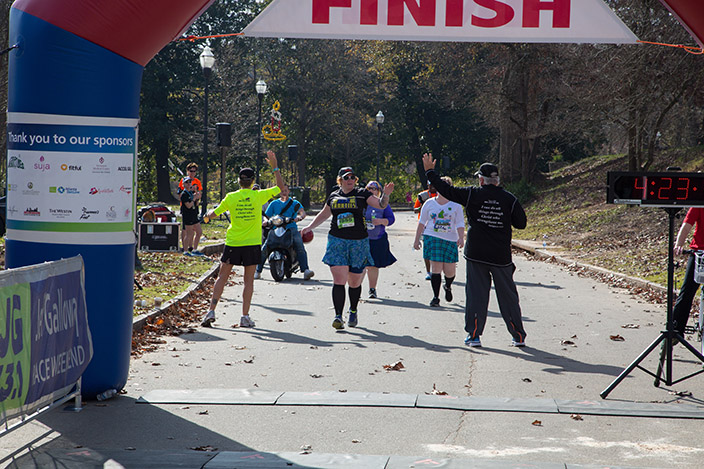
Download the following sheet for convenient use.
